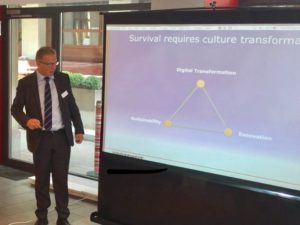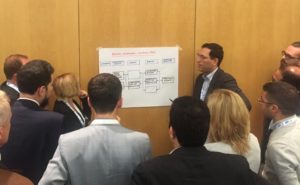Survival requires culture transformation
Survival requires cultural transformation
In partnership with Tesla Switzerland and Ms Elga Reana Tozzi, I recently had the pleasure to organise the event “Executive Forum Digital Transformation” (in German) at the Tesla Showroom in Zürich, Switzerland.

Have the courage or “Wait and Die!
The topic of my presentation at the Executive Forum was ”Inspiration for the courage”. Let me explain what I mean. The speed of disruption change stemming from Digital Transformation, Robotisation, Automation, Globalisation is ever increasing. In a couple of years, the disruptive ”wind of change” will be blowing constantly much stronger than today. In the light of this expected development, it is not enough for companies to define and implement a ”digital strategy” or to create a dedicated digital unit, embedded in the current organization or not. Digital Transformation is about Digital BUSINESS Transformation which requires culture transformation. Organizations need to be able to quickly and constantly adapt their business models, as required.
Did you know that:
- Only about 50% of companies have actively embarked on the Digital Business Transformation journey?
- Company life cycle has already shrunk from 60 down to 15 years?
- About 50% of current companies are expected to disappear from 2020 onwards?
What’s required to survive?
Remove barriers to Strategy Execution
Today, since most organizations are still operating according to the old fashioned silos, it is not possible to speedily adapt business models to cope with the speed of new entrants and ever changing constellations of operating models. At the same time, many companies are struggling to execute strategies for accelerated, digital growth. As a matter of fact, according to a strategy execution survey, 96% of executives face some hinder to strategy execution.
Drive culture transformation
Gartner foresees that within three years, 80% of all digital business solutions must be able to deal with situations in real time. This situation requires a new organisational culture and survival reads culture transformation, to shape agile organizations, putting huge demands on the leadership, which is mainly silo oriented ”you work for me” ”don’t look left and right”, ”sit still in the boat, I’ll let you know what to do”. While my statement may be largely exagerated in many instances, there is still too much of this stuff going on. Let’s instead empower the workforce to its full potential, driving innovation. A proof to my statement – Only 13% of the world’s active workforce is actively engaged and passionate towards their occupation…it’s time to smash the silos and start working transversally throughout the organisation. This new Ways of Working (WoWs) need to be enabled by servant leadership, having the courage to make swift decisions in this world of VUCA (Volatility, Uncertainty, Complexity and Ambiguity) and release the innovative power of the entire organisation, at individual and team level.
Align strategy and put People First
Even if and when the above challenges are beeing addressed, the foremost issue hindering strategy execution is the fact that in many cases the Board and the Executive Management Team have not ”switched on their GPS” and typed the same ”address” or have switched on their GPS without entering an ”address” at all. The meaning of ”address” here is, a common direction i.e. shared strategic objectives. The consequence of a lack of shared objectives is that the organization gets confused, i.e there is no common ”WHERE” and reason(s) for the change/transformation ”WHY” are unclear, i.e. the WIIFM (What’s In It For Me) are not clearly understood by the entire impacted organisation. With no sense of direction, the transformation will be very painful and costly, if successful at all.

Where are we heading?
Solution
As discussed above the starting point for successful strategy execution is to ensure joint strategic alignment between the Board and the Executive Management Team. Another key aspect is to focus early enough on the people side of change, i.e. Change Management. My recommendation is to base the Change Management framework on Prosci, one of the two leading independent Change Management bodies worldwide.
To get your Digital Business Transformation journey started successfully, consider these steps:
- Strategy Alignment. Make sure that the Board and Management Team jointly have their “GPS switched on” with the same “address”. I call this the EXPLORE phase.
- Bridge the Gap. Link the strategy and its objectives with the required changes, based on Benefits Realisation, i.e. produce a ”Benefits Dependency Map (BDM)”. This is part of the FOCUS phase.
- 90 Days Planning. Since organizations normally do not have spare capacity and the Leadership team is busy with Run-The-Business (RtB) or Business As Usual (BAU), the most common hinder and a major reason for the failed change, is the insufficient capacity and capability to focus on change/transformation (CtB, Change-The-Business). In order to alleviate this challenge to some extent, my recommendation is to prepare a 90 days implementation plan, where 3 Big Rocks from the BDM are prioritized, together with the identification of 3-5 Quick Wins. The exercise will result in a comprehensive actions list, to be finished within the aforementioned 90 days. This is the EXECUTE phase.
Then it’s about to make it happen. Remember: What’s most important is to put PEOPLE FIRST.
What’s the situation in your organisation?
Take our free Digital Business Transformation Assessment and find out your result instantly.
Upon completion of this self-assessment, you may schedule a free 30 min call to evaluate your assessment results with some tips and your own report.
Watch the video: Digital Transformation is about People First
I help SME’s (50-500 employees) to bridge the gap between strategy and execution. My clients are Chairmans, CEOs and CFOs with some kind of growth challenge, realising that disruptive transformation is needed.




